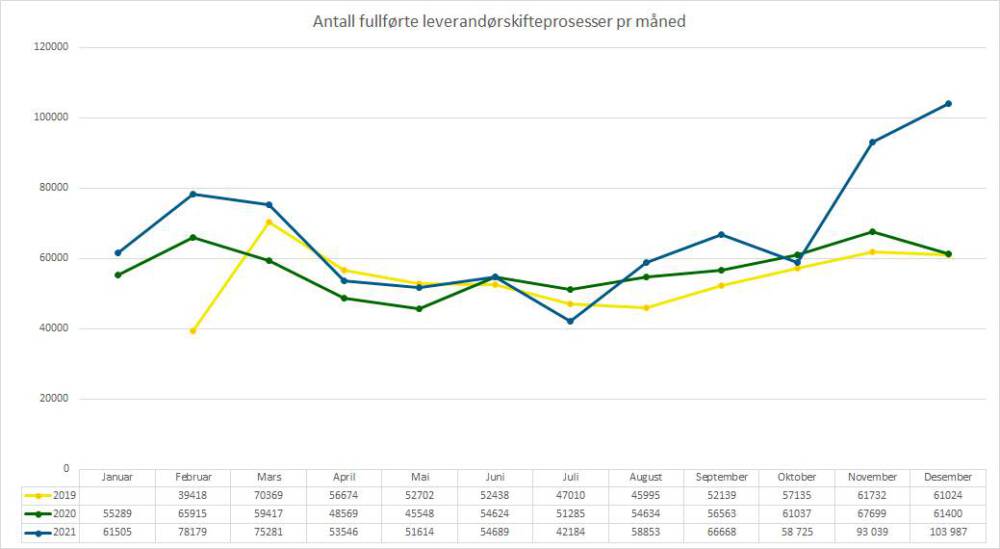Electricity consumption in 2021 despite high prices has increased. Growth in particular was recorded for holiday homes and was significant. At the same time, a record number of people changed the electricity supplier.
2021 was a special year, with record high prices in southern Norway, record production and record consumption. All measurement data on electricity consumption in Norway is collected at Elhub, a subsidiary of Statnett. The following trends in electricity consumption stood out over the past year:
- Consumption increases significantly in holiday homes
- Household electricity consumption is rising, but more moderately
- More and more people change supplier during the year
- Stronger competition and new players among electricity suppliers
- There will be more plus customers, those who produce more electricity than they consume - including: By solar cells
- The interest in the energy market has never been as high as in 2021, and we can see some interesting trends in the figures from Elhub. New players settle and take market shares, and the pattern of consumption changes. Elhub's mission is to support the innovative energy market through, inter alia, contributing to the efficient exchange of information and competition between players. This will enable electricity consumers to choose new smart services and alternative service providers. The data in Elhub can also be used to understand trends and analyze the effects of various measures, so that the enormous value of electricity production is captured in the future and the electricity grid is at its best, says Sigbjørn Høgne, CEO of Elhub.
Electricity consumption increase in all segments, the largest increase for holiday homes
Norway's total electricity consumption has increased from around 134 TWh in 2020 to around 140 TWh in 2021, a new consumption record. In the case of households, consumption increased from approx. 38 TWh to approx. 40 TWh. Average consumption in a household has increased from around 4%, from 15 kWh to approx. 300 kWh. In the case of holiday homes, consumption increased from approx. 16 TWh to approx. 000 TWh. Average consumption in summer houses has increased from approx. 2,5 kWh to approx. 2,8 kWh, an increase of almost 7400%.
In the case of industry, consumption in 2021 amounted to 89 TWh, an increase of 3,5%. from around 86 TWh in 2020
When electricity is transmitted, there are always losses on the way from the producer to the consumer. In 2021, this loss amounted to approx. 8 TWh. In addition to the physical loss of the grid, electricity can also be lost in the so-called "Administrative loss" - this is consumption at measurement points where, for various reasons, the recipient of electricity has not been registered. We are pleased that the administrative loss has been reduced from approx. 0,13 TWh in 2020 to approx. 0,08 TWh in 2021.
A few new players on the market and a record number of supplier changes
The number of registered supplier switching processes in Elhub was approximately 800 in 000, which is a record result. The volume of supplier changes was particularly large at the beginning of the year, when there was a lot of media coverage of the Consumer Council's mention of energy suppliers, and at the end of the year, when prices in southern Norway was top notch.
Last year, 10 new energy suppliers and 8 new third parties were also registered in the Norwegian energy market. A third party in Elhub is a company that collects consumption data from Elhub and uses it to offer services in the field of energy consulting, energy efficiency and the like. New players are engaged in offering new services and pricing models to electricity consumers, and competition in the electricity market appears to be stronger. Some of the newly created players have significantly increased their customer base in a short time.
At the same time, consolidation in the market continued, both among network companies and among energy suppliers, and several smaller network companies and energy suppliers merged with larger companies. At the end of the year, 134 network companies, 155 energy suppliers and 38 third parties were registered in Elhub.
More plus for customers and an increase in the number of measuring points
All active measuring points for electricity consumption and production are registered in Elhub. The number of measuring points steadily increased throughout the year and at the end of the year there were almost 3,3 million active measuring points on Elhub. This is due to both the increase in the number of new households and new holiday homes, with just over 9000 combined measuring points among the consumption measuring points. These are measuring points where the so-called plus customers are powered by the electricity they produce, mainly from solar panels on the roofs. The number of plus customers increased by approx. 35% compared to 2020. Plus customers supplied approximately 34 GWh of electricity to the grid, compared with 27 GWh in 2021.
The number of measuring points billed by profile, i.e. old meters read manually, has been reduced to almost 60 and currently accounts for less than 000% of profile billed electricity meters. The consumption related to this type of measuring points has also decreased sharply in recent years and now amounts to a total of 2 TWh per annum.
Increased production from both hydropower and wind farms
Electricity production reached a record level in 2021. A total of approximately 157 TWh was produced, compared with 154 TWh in 2021, 93% of which came from hydropower. Wind energy was responsible for about 12 TWh of electricity production (about 6%). Electricity was also generated from heat (1,5 TWh) and solar energy (0,03 TWh). Net exports decreased by around 3 TWh from 2020 to around 17 TWh in 2021. Especially in the second half of the year, exports decreased compared to the previous year.
Source: Statnett
Read our next article: A white stream in cinemas in Norway. There are no worse enemies than best friends.


